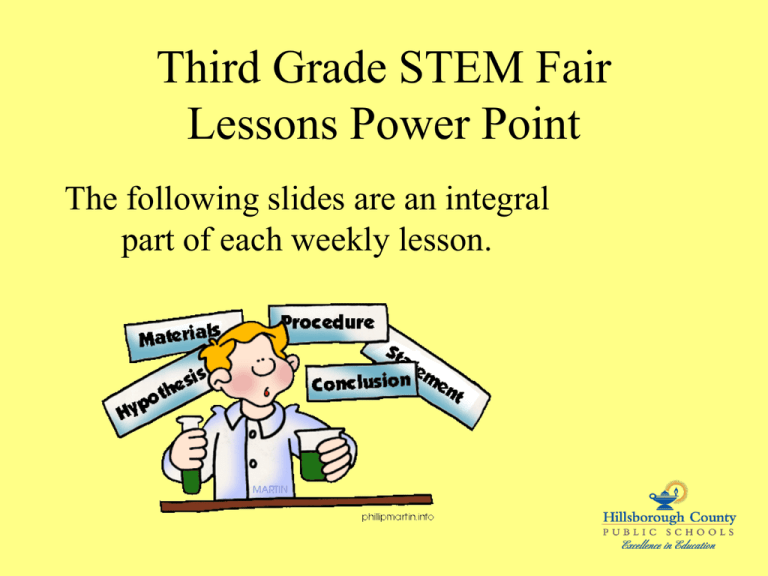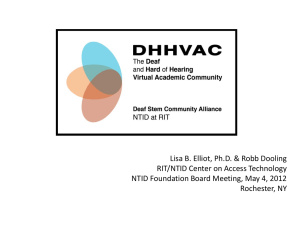Science Fair For 3rd Grade
advertisement

Third Grade STEM Fair Lessons Power Point The following slides are an integral part of each weekly lesson. Scientific Method Please click on the clipboard below to introduce the student to the Scientific Method. Scientific Method Scientists do not always follow these steps in this order or even go through all of them every time, but for STEM Fair we will. 1. 2. 3. 4. 5. 6. 7. Ask a question and state a purpose. Research Hypothesis Procedures(variables, materials, step by step directions.) Collect data. Create a graph. Draw a conclusion. Week 1 Introduction to STEM Fair: Logs, Questions and Topics Essential Question • What is a STEM Fair Project? • What is a STEM Fair Log? • What is a testable STEM Fair Question? Log • Projects without logs will be disqualified. • The log IS the project. The show board is just a commercial for the project. • Each entry should be dated. • Research notes, measurements, observations, and test results should be included. Log • The first thing you need to do to begin a STEM Fair project is to begin writing in a log. • It is a record of everything you think and do as you work on your STEM Fair project. Log • You should record in your log every time you do anything related to your project. • Your log is like a diary or journal of your progress in your investigation. • Keep everything you write in your log even if you change your mind or start over. Example of log entry for question: August 20, 2011 I saw a picture of icebergs floating. They look really cool and pretty. Ice floats in a glass of water too. I wonder if ice is lighter than water. My question is: Does the mass of water change when it goes from a liquid to a solid. No, How does going from a liquid to a solid affect the mass of ice? is better. The boat in the picture floats too. Is the boat wood or metal? I think metal sinks, but metal boats float. I know wood will float.. You can investigate the question yourself. • Good: How do shade trees affect temperature of areas on our playground? • Bad: What are the temperatures on Venus? (though you can look it up, you cannot build a rocket, go to Venus and study this on your own and get back before the due date) A good question is testable. • Good: How does changing the height of the roller coaster affect the distance of the marble? • Bad: Who invented roller coasters? A good question cannot be answered yes or no. (There are exceptions to this rule) • Good: How does the type of water affect the growth rate of a plant? • Bad: Can plants grow in water? A good question tells you what you need to measure. • Good: How does the species of the orange affect the amount of juice it has? • Bad: Are oranges juicy? The answer is a fact, not an opinion. • Good: How does the brand of soap affect the amount of bubbles produced? • Bad: What kind of soap smells the best? Brainstorming Topics (Grades 3-5) • Task: In your STEM fair log, create a list of as many testable questions that you may want use to design an experiment. Think of as many questions as you can in a list. A list of questions might look like this one: Questions: • How does the shape of the wing affect how far a paper airplane glides? • Does a baseball roll farther on artificial grass? • Do most rocks erode in the rain? Can some rocks float? • What are good ways to cool off when you are hot? What is a Good Question? A good science investigation question: • Can not be answered with one word such as yes, no, or purple. • Tells you what you need to measure. • Is something you can investigate yourself. • Is answered with a fact, not an opinion. Choosing a Topic In your STEM fair log, choose a topic that you would like as your STEM fair project. Explain why you are choosing that question. Choosing a Topic Task: In your notebook record in your log what you did today. Research Involving Animals • Human/Animal Research form MUST be filled out prior to the beginning of the project. • No surgery or dissection may take place • Neither physiological or psychological harm to the animal can result • Must be supervised by an adult. Week 2 How to Write Your Purpose & Conduct Research Essential Question • What is a STEM Fair Purpose? • Where do scientists look to find information? Purpose The purpose of the project should tell what you want to find out. “The purpose of my project is to find out…” It is really just restating the question. Purpose So, let’s practice writing a purpose. Purpose Task: Use your question to write your purpose in your STEM fair log. Research • Before you can begin your project, you need to learn more about the topic. • Write down questions that you would need to know in order to help build knowledge about your topic. • You will write the information that you learned in your STEM Fair log. • You will use this information to make your hypothesis. Research Task: • After you have recorded the information that you learned, take the opportunity to record in your log what you did today. • Don’t forget the date!!! Week 3 Hypothesis Essential Question How do you use research to form a hypothesis? Hypothesis •The hypothesis is what you predict will happen when you perform the experiment based on your research. •It doesn’t matter whether you are right or wrong; in your conclusion, you will tell if your hypothesis was correct or not. •It is what you think the results of your experiment will be and WHY you think that. Hypothesis In your log write what you think the results of your experiment will be and WHY you think that. Based on my research, I think… will happen because ... Remember to use the information from your research to explain why you think this will happen! Hypothesis Task: In your notebook record in your log what you did today. Week 4 . Materials Essential Question How do you find and formulate a materials list? Example of Materials List Materials • • • • 2 – 16oz Office Depot clear plastic cups 130ml tap water 1 Thermometer 16 oz of ice from cafeteria ice maker Materials This is a list of ALL the materials you need to perform your experiment. You must also include how much. . Materials HOW, WHEN, and WHERE will you get you materials? Explain in your log. Materials Task: In your notebook record in your log what you did today. Lesson 5 Variables Essential Question •What is a Manipulated variable? •What is a Responding variable? •What is a Constant variable? Variables There are 3 kinds of variables. You will list the variables for your STEM Fair project today. 1. Manipulated What you are changing on purpose. 2. Responding The changes are you measuring. 3. Held Constant Everything that stays the same. Examples of VARIABLES: Question ? Do all brands of paper towels absorb the same amount of Manipulated Variable Responding Variables (what You Change) (What You Will Measure) Brands of paper towels Constants (What you keep the same) Size of paper towel Amount of water that is absorbed by each towel Amount of water poured on each paper towel Temperature of the water used Container towels are placed in List your VARIABLES: Question ? Manipulated Variable Responding Variables (what You Change) (What You Will Measure) Constants (What you keep the same) Variables Task: In your log, list your variables . Remember to label each variable. Week 6 Step by Step Directions Essential Question What are Step by Step directions and how are they used in a STEM Fair project? Step by Step Directions What are Step by Step directions and how are they used in a STEM Fair project? Step by Step Directions – •Step-by-step directions are like a recipe. •Anyone who reads them will be able to duplicate the investigation and get the same results. Step by Step Directions – •Direction steps need to be numbered. •The experiment needs to be done 5 or more times so they will have sufficient data to make an accurate conclusion. •Step number one is always, “Gather materials.” Examples of Directions 1. 2. 3. 4. Gather Materials Fill cup to ½ way mark with ice. Add 130 ml of tap water Swirl cup for 1 minute. (hold by top edges of the cup) 5. Record water temperature. (Keep thermometer in water, look at eye level) 6. Add 2 more ice cubes. 7. Repeat steps 4 and 5 When you write your directions there are a few things to remember: Write them clearly so someone else may follow them and get the same (or similar) results. Be very specific and to the point. Remember to indicate how many trials are necessary. For Example: “Repeat steps 2-5 four more times for a total of five trials” Make sure to indicate when data should be collected and what kind of data. Step-by-step Directions Task: In your log, record what you did today. Week 7 DATA Essential Question What is the difference between quantitative and qualitative data? What is a data table? What is a graph and how does a line graph differ from a bar graph? DATA •Data refers to the information gathered in the investigation •This is in the form of tables and charts. •You can also use photographs or drawings to show the information you gathered but pictures do not replace the data. DATA •To collect your data you will follow your step by step directions exactly. •You will complete at least 5 trials and record the information in your log. •You will use the data to create a data chart. DATA The more trials you do the more accurate the results of your experiment will be. The minimum for STEM Fair is five trials. Scientists often repeat experiments thousands of times. Quantitative and Qualitative data Distance a toy car will Roll in Meters Trial Tile Floor Carpet Sidewalk Trial 1 4.3 2.4 2 Trial 2 4.4 2.7 2 Trial 3 3.5 1.8 1.8 Trial 4 4.5 2.8 2.5 Trial 5 4.8 2.5 1.6 Data Collection Task: In your STEM fair log, create your data table. Data Task: In your log, record what you did today. Week 8 Data Collection& Graphing Essential Questions What is the difference between quantitative and qualitative data? What is a data table? What is a graph and how does a line graph differ from a bar graph? Data Collection & Graphing Use a bar graph or line graph to display data. This is the same information gathered and already recorded on your data chart. Graph •A bar graph – shows comparative data •A line graph – shows data over time. (such as growing plants) •Horizontal Axis: The manipulated variable (what you changed on purpose) is displayed on the horizontal axis. •Vertical Axis: The responding variable (what happened as a result of what you changed) is displayed on the vertical axis. Example of a graph: Distance Toy Car Travels When Rolled Down Ramp Onto Various Surfaces Meters Key Trials Week 9 CONCLUSION Essential Question How do you analyze the data in a graph and share your results? What is a conclusion and what should be included? Analyzing Data *Look at the graph. *Identify 3 statements about your data The Example Graph: • The cars travel the farthest on the tile floor. • The cars traveled the least distance on the Sidewalk. • In trial 3, I noticed that the car travel less than all the others. CONCLUSION My hypothesis was supported (or not supported) by the data. (Explain) I found out that… If I were to do this project again, I would change…because….. The way this is connected to the real world is… CONCLUSION A problem I had or unusual event was…. Describe your data in detail. What does your data mean? Compare the results with you background information. Explain why the experiment is important. Task: Look at your data and graph, write a conclusion using the format you learned. Task: In you log record what happened today. Week 10 Display Essential Question How do you display all of the components of a STEM Fair Project? Purpose My Title Graph Hypothesis Procedure: Data Materials Variables Conclusion Step-by-Step Directions Optional Research Paper Data Log DRAWINGS OR PHOTOGRAPHS – Photographs and drawings are an excellent idea. Show what you have learned… Displays • Must be durable and self-supporting • No student or school name can be on the front of the display, or on/in the log/research paper. • Photos are great, but there should not be school shirts in photos. • Dead animals, plants, and food may NOT be part of display. • Projects involving human blood, mold or fungus are prohibited • Glass items and plastic “baggies” are not to be displayed • Straight pins, tacks, or staples are not to be used to secure materials onto display boards Requirements ALL projects must have a separate DATA LOG that is clearly marked. Group project members must each have their own log. Projects without LOGS will be disqualified A research paper is not required.








